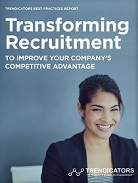
Understanding the latest trends and adapting to new challenges is crucial for both employers and job seekers. Our recent conversation, The Evolving Labor Market: Trends, Challenges and Opportunities, featured our Recruitment Solutions Senior Leadership and recruiting experts, who dove into the dynamic world of work, offering valuable insights and practical advice on navigating this evolving landscape.
They began with an overview of the significant trends shaping today’s US labor market. The post-COVID labor market was compared to a steam train struggling to climb a steep hill, only to crest and descend into more stable, flat terrain. The labor market has seen dramatic shifts from the initial chaos of the pandemic to a more stable environment today. Unemployment rates, wage growth and job openings have all stabilized, creating a more predictable landscape for employers and job seekers. Following the Great Resignation, where many workers left their jobs, we are now witnessing the Great Stay. Employees are staying put, leading to lower quit rates and a more stable workforce.
The conversation highlighted the importance of labor market analytics for hiring managers. Data-driven insights can help set realistic expectations and streamline the hiring process. Hiring managers should use labor market data to understand the availability of talent and adjust their requirements accordingly. This helps avoid unrealistic expectations and ensures a more efficient hiring process. Providing competitive salaries and benefits is also essential. Hiring managers should use compensation data to align their offers with market expectations and attract top talent.
The growing role of AI in recruitment was another key topic. AI tools are transforming the hiring process, both for recruiters and job seekers. AI is being used to automate various aspects of recruitment, from resume screening to interview scheduling. This helps streamline the process and improve efficiency. While AI offers many benefits, it also presents challenges. For example, AI-generated resumes can make it difficult for recruiters to identify truly qualified candidates. It’s important to balance the use of technology with human judgment.
Several key trends will shape the labor market in the coming years. Improved workforce planning tools will help organizations better anticipate and meet their staffing needs, which will be crucial for managing the demographic shifts and retirements of senior leaders. Additionally, HR professionals will increasingly become people strategists, focusing on aligning workforce planning with business goals and driving revenue generation.
Our conversation provided a wealth of insights into the evolving landscape of work. And while this was focused on the US labor market, many of these takeaways can be used globally. From understanding labor market trends to leveraging AI in recruitment, the key takeaway is staying informed and adaptable. As the labor market continues to change, employers and job seekers must be proactive in navigating these shifts to succeed.
To watch the session, click the button below!



